Mastering Kitesurfing: Essential Tips for Beginners
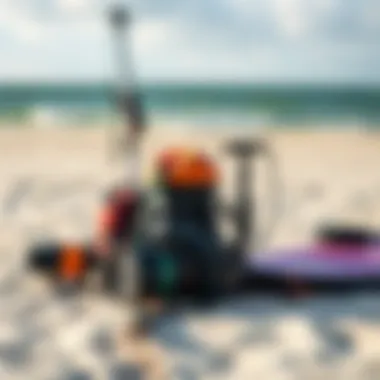
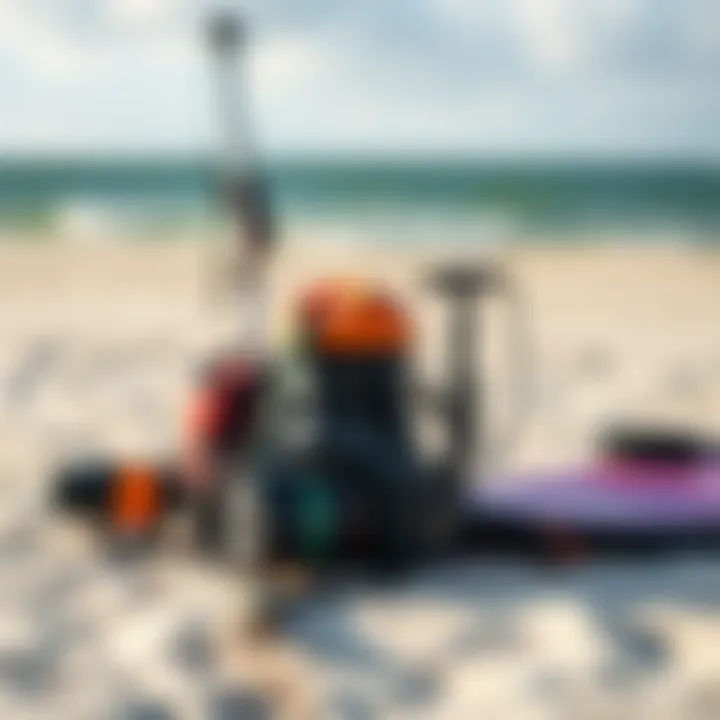
Intro
Kitesurfing is more than just a thrilling water sport; it’s a dance with the wind that allows you to glide over the waves with exhilaration and grace. For those aspiring to dip their toes into this captivating activity, understanding the essentials is crucial. This guide uncovers the fundamental components of kitesurfing, blending safety measures, gear selection, and skill development. These elements not only shape a person’s learning experience but also promote responsible practices that benefit the environment and enhance one’s enjoyment of kiteboarding venues.
Navigating the early stages of kitesurfing can feel like deciphering a complex puzzle. Whether you’re a curious novice or someone who simply wants to polish up on your skills, knowing where to start and what to consider is vital. In this guide, we’ll cover the must-have equipment, from the right kite and board to safety gear and local regulations. We’ll also delve into techniques that will help you progress and become a more confident kitesurfer. Ready to ride the winds? Let’s explore the essentials.
Gear Selection
Choosing the proper gear is the first step in your kitesurfing journey. Each item plays a pivotal role in your performance and safety. Before heading out into the waves, it’s essential to know what options are available and how to select the right ones for your needs.
Types of Kites
Kites are the heart of kitesurfing, driving your performance on the water. Each type comes with its unique characteristics suited for various conditions and skill levels. Here are the main types:
- C-Kites: Known for their performance in freestyle and big air, these kites offer excellent control and precision. They are ideal for advanced riders.
- Bow Kites: These kites provide a large wind range and are fantastic for beginners due to their ease of use and stability.
- Delta Kites: Combining aspects of C-kites and bow kites, they offer good depower and versatility, making them suitable for a wide audience.
When selecting a kite, consider factors such as wind conditions, your weight, and your skill level. This will help ensure that your picking the right fit for your learning phase and beyond.
Choosing the Right Board
Your board allows you to harness the power of the kite effectively, which makes its selection important. There are multiple types of boards available:
- Twin Tip Boards: Common among beginners, these boards are symmetrical and easy to ride in both directions. They offer forgiving handling and are great for learning tricks.
- Directional Boards: More suitable for wave riding, these boards look similar to surfboards and are designed to ride downwind.
- Foil Boards: If you're feeling adventurous, these innovative boards elevate above the water, providing a unique riding experience.
Selecting the appropriate board should take into account the kind of kitesurfing you wish to pursue, your comfort level, and the specific conditions in your local area.
Skill Development
Now that you have your gear sorted, it’s time to focus on honing your kitesurfing skills. Mastery of the essential techniques forms the backbone of your progression.
Essential Techniques
Start with the basics. Understanding how to control the kite in various wind conditions is crucial. Key techniques include:
- Kite Control: Learn to maneuver the kite using the bar and lines. This will help you gain confidence and develop a solid foundation.
- Body Dragging: Practice body dragging, which helps you learn how to stay connected to the kite while being pulled through the water.
- Water Start: This is your gateway from water to air. Understanding how to position your board and harness the kite’s force will allow you to lift off.
Progression Tips
As you become more comfortable, consider these tips to elevate your game:
- Practice Regularly: The more time you spend on the water, the quicker you'll develop your skills.
- Take Lessons: Seeking guidance from a qualified instructor can fast-track your learning. Look for local schools that can provide hands-on training.
- Join a Community: Connect with other kitesurfers. Engaging with fellow enthusiasts can lead to valuable tips, support, and an enjoyable learning atmosphere.
Learning kitesurfing is not just about mastering technique; it’s about enjoying the ride, respecting the environment, and creating memories.
Ending
As you embark on your kitesurfing journey, keep in mind the importance of sustainable practice and local regulations. These not only keep you safe but also preserve the beauty of nature for future generations. This guide provided an introduction to gear selection and technique development, but your journey is continuous; there's always a new wave to ride and a new skill to master. With diligence and passion, you'll soon be gliding through the water, harnessing the wind like a seasoned pro.
For more information and community support, consider checking resources like Wikipedia or visiting forums on Reddit. Happy kitesurfing!
Prelims to Kitesurfing
Kitesurfing is not just a sport; it’s an exhilarating dance between wind and water. This guide acts as a beacon for those ready to embark on their kitesurfing journey, emphasizing the importance of getting a solid grounding before diving into the waves. Understanding the nuances of kitesurfing prepares you for the thrill that lies ahead, while also ensuring a safe and enjoyable experience.
Understanding the Sport
Kitesurfing, aptly described as a blend of surfing, windsurfing, and paragliding, requires a unique set of skills and awareness. At its core, the sport involves harnessing the power of the wind to propel oneself across the water on a board, using a large kite for lift and control. The harmony between rider, kite, and ocean is intricate yet rewarding. Each session on the water teaches new tricks and refines techniques.
For beginners, it’s crucial to grasp the basic principles: how to control the kite, manage the board, and understand the environment. This foundational knowledge not only boosts confidence but also lays the groundwork for more advanced maneuvers down the line. Understanding wind patterns and how they influence riding conditions is also key, as this knowledge can make the difference between a smooth ride and a challenging experience.
The Appeal of Kitesurfing
What draws people to kitesurfing? For starters, the sheer exhilaration of gliding over the waves under the power of wind is second to none. The sport appeals to adventure-seekers and those drawn to the outdoors alike. The feeling of freedom one experiences while kitesurfing makes it addictive; it’s a blend of fitness, adrenaline, and fun.
Moreover, learning kitesurfing opens doors to a vibrant community. Meeting fellow enthusiasts at local beaches or participating in global competitions fosters connections and friendships that often last a lifetime.
For many, kitesurfing represents more than just a way to soak up the sun; it signifies a lifestyle. Emphasizing environmental stewardship, the sport encourages respect for nature and promotes sustainable practices.
"Kitesurfing is like painting a masterpiece where the surf and the wind are your colors. Together, they create an unforgettable picture of freedom and adventure."
In summary, the introduction to kitesurfing offers crucial insights into the sport, the allure of learning, and what awaits those willing to take the plunge. Not only does it present vast opportunities for personal growth, but it also fosters a sense of belonging in a unique and lively community.


Selecting the Right Location to Learn
Choosing the right location to dip your toes (quite literally) into kitesurfing can make all the difference in your learning curve and overall enjoyment. Not only does the right spot provide ideal conditions for beginners, but it also ensures your safety while you’re getting your bearings. This section dives into the local beaches that offer optimal conditions for learning and explains how to read the wind patterns, which are often the lifeblood of kitesurfing.
Local Beaches with Optimal Conditions
When you’re starting your kitesurfing journey, finding a beach that caters to novice riders is crucial. Look for areas that are known for their gentle waves and consistent wind—these spots can often be a beginner's best friend. Think of sandy expanses where you can launch without worrying about rocky shores or heavy surf. Places like Kahana Bay in Hawaii, with its shallow waters and steady breezes, are perfect examples.
Key Elements to Consider
- Shallow Waters: Ideal for practicing without the fear of deep plunges.
- Consistent Wind: Take time to check local forecasts and gather information about typical wind conditions.
- Local Kite Schools: Being near instructors can help you feel more comfortable, and having lessons nearby is a significant boon.
- Limited Crowds: Heavy traffic can lead to accidents. Try to find less crowded spots where you can focus better.
Consider beaches like Puerto Rico’s Isla Verde or Tarifa in Spain, which are famous for their pristine conditions. Ask local kitesurfers or dive into forums on sites like reddit.com to gather personal recommendations.
Understanding Wind Patterns
Wind patterns are the invisible strings that control the kite. Understanding these patterns can save you not only time but also potential headaches. The first step is to recognize that the wind direction plays a pivotal role in how and when to kite.
Things to Keep in Mind
- Onshore vs. Offshore Winds: Onshore winds blow from the water to the land and are generally safer for beginners, whereas offshore winds pull you away from the shore and can be dangerous.
- Wind Speed: A steady wind speed of 12-20 knots is typically favorable for newcomers. Too little wind, and your kite won’t lift; too much, and you could find yourself overwhelmed.
- Local Variations: Every location can have its quirks. For instance, some spots have thermals or gusty winds that can change rapidly, making forecasts a dicey game.
If you're unsure about reading the winds, consider spending some time just watching the conditions before you launch your kite. You might even think about downloading a wind meter app to get a better grasp of what's happening in real-time.
"> Learning in a proper location with favorable wind conditions is one key to gaining confidence and skill on the water. Never overlook where you start your kitesurfing adventure.
Finding your footing in kitesurfing begins with these essential considerations about local beaches and wind patterns. Equip yourself with this knowledge, and you’re setting out on the right path to become a capable kiteboarder.
Essential Equipment for Beginners
When stepping into the world of kitesurfing, having the right gear can make all the difference. It's not just about riding the waves; it's about doing so safely and effectively. Each piece of equipment serves a distinct purpose, ensuring that the beginner not only learns but thrives in this exhilarating sport.
Kites and Control Bars
Kites are, without a doubt, the heart of kitesurfing. They come in various shapes, sizes, and designs, each tailored to different wind conditions and skill levels. For beginners, choosing a stable, user-friendly kite is paramount. This often means opting for a larger kite that can generate lift even in lighter winds, making the learning process smoother.
Control bars are the interface between the kite and the rider, allowing for steering and control. A good control bar should feel comfortable in the hands and allow for precise adjustments. Many manufacturers create bars with safety features, like quick-release systems, which can be a lifesaver in tricky situations.
Boards and Foot Straps
A board is where the magic happens; it's your platform for riding the waves. Beginner boards tend to be wider, providing more stability and making it easier to maintain balance. They also have a larger surface area, which assists in keeping the rider afloat when learning. Look for boards with a forgiving flex, allowing for a softer landing when taking a tumble.
Foot straps are crucial as they secure the rider to the board. Well-designed straps enhance comfort and performance, ensuring that a surfer doesn’t accidentally lose their board in choppy waters. Beginners should focus on adjustable straps, which can accommodate various shoe sizes, making it easier to share gear or grow into it.
Safety Gear: A Necessity
When engaging in any water sport, safety gear shouldn't be an afterthought. For kitesurfers especially, the right protective equipment can prevent injury and promote peace of mind while riding.
Helmets
Helmets are vital, especially for beginners who are experimenting with jumps and tricks. A good helmet not only provides head protection but also shields against potential impacts from the board or other obstacles in the water. Choosing a lightweight helmet designed specifically for water sports can make a significant difference. Many helmets come with adjustable chin straps for better fit, and some even have ventilation, maximizing comfort during those long sessions.
Impact Vests
An impact vest is another essential piece of safety gear. This vest helps absorb the shock from falls, minimizing the risk of injury during learning phases. Its buoyancy contributes additional flotation, which can be quite advantageous for beginners who may occasionally struggle to stay upright. Impact vests generally fit snugly, allowing for freedom of movement while providing that all-important padding.
Safety Leashes
Safety leashes are a fundamental aspect of kitesurfing gear. They connect the kite to the rider, providing a failsafe if something goes awry. A well-designed leash should allow the kite to detach safely when necessary, reducing the risk of injury from runaway kites. Many riders opt for leashes with quick-release mechanisms for quick disengagement from the kite, enhancing safety.
"Remember, it's not just about the thrill of riding; it's about riding smartly and safely for a lasting adventure."
For further information about kitesurfing equipment, consider checking out resources like Wikipedia and community discussions on Reddit.
Embarking on the kitesurfing journey armed with the right equipment can set the stage for success and enjoyment.
Choosing a Reputable Instructor
Selecting the right instructor can make or break your kitesurfing experience. A skilled instructor not only teaches you the ropes but also ensures that you develop a solid foundation in safety and technique. When you're just starting out, the last thing you want is to find yourself in deep water—metaphorically and literally—because of inadequate teaching. Having a reputable instructor can mean the difference between enjoying the thrill of riding the waves and pulling your hair out trying to figure things out solo.
Qualifications to Look For
When searching for a kitesurfing instructor, you should be looking for certain qualifications to gauge their competency. Here are some of the most important:
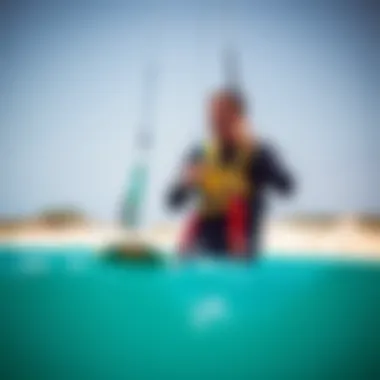
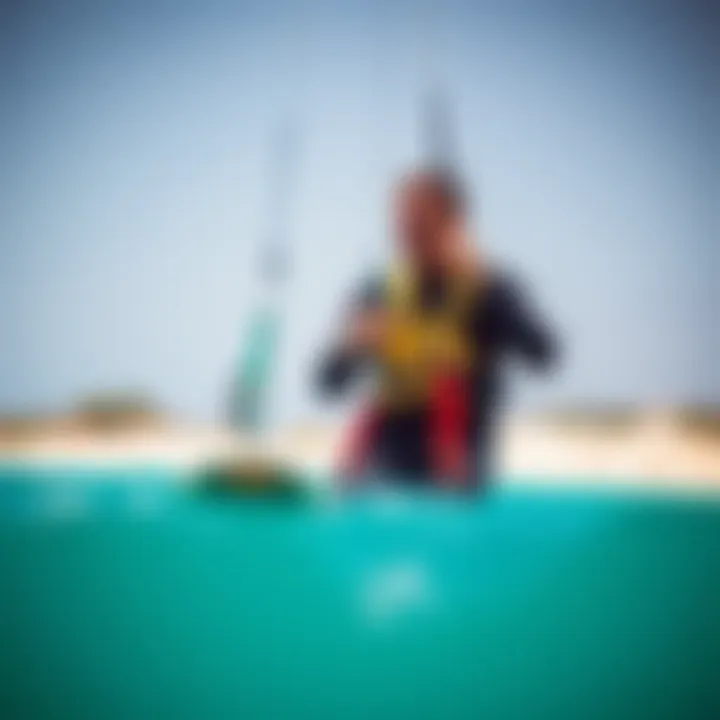
- Certification: A reputable instructor should have certification from established organizations such as the International Kiteboarding Organization (IKO) or the American Kiteboarding Association (AKA). Their certification usually indicates they’ve successfully completed necessary training and adhere to safety protocols.
- Experience Level: Ideally, you want someone with a fair bit of experience under their belt. Instructors who have been teaching for several years will usually have encountered various scenarios and know how to handle them. If an instructor can recount stories from their kitesurfing days, it’s often a good sign.
- Teaching Style: Different instructors have different teaching styles. It’s a good idea to discuss with potential instructors how they plan to teach you. Make sure their methods resonate with how you learn best. If you prefer a hands-on approach rather than theoretical discussions, make that clear.
- Knowledge of Local Conditions: A good instructor knows the local environment, including different wind patterns and tides. This knowledge will enhance your learning experience, allowing you to practice under optimal conditions.
Reviews and Recommendations
In this age of information, you really can’t underestimate the power of reviews. Before committing to an instructor, dive into online resources or consult friends who have taken lessons. Here are several avenues to explore:
- Online Reviews: Websites like Yelp or Google Reviews can offer valuable insights. Keep an eye on comments about professionalism, safety, and teaching methodologies.
- Kitesurfing Forums: Platforms such as Reddit or specialized forums can be gold mines. You might find discussions where past students share their experiences with particular instructors.
- Local Community: If you have friends or family who are involved in kitesurfing, asking for recommendations can lead you to excellent instructors. A personal recommendation often speaks louder than any online review.
Remember: An instructor's reputation is built not just on their skills but also on their ability to foster a safe and enjoyable learning environment.
Learning the Basics of Kitesurfing
Learning the basics of kitesurfing is the bedrock upon which every aspiring kiteboarder builds their skills. This phase, often a blend of exhilaration and trepidation, shapes one's entire kitesurfing experience. Mastering the foundational elements not only enhances confidence but also ensures safety—something that cannot be overstated when a large kite is involved.
When you embark on this thrilling journey, understanding the essential skills can vastly smooth the learning curve. For many, the thrill of kitesurfing is matched by the complexity, as it melds elements of surfing, sailing, and flying into a cohesive experience. With a solid grounding in the basics, you set yourself up not just for immediate enjoyment but for long-term success in your kitesurfing venture.
Initial Ground Training
Ground training is often regarded as the first step every newcomer to kitesurfing should take. Before you ever touch the water, you will want to become intimately acquainted with your equipment. This is not just about getting familiar; it’s about transforming into a responsible, prepared rider.
During ground training sessions, you will learn to control the kite on land. Here, you’ll understand the various parts of the kite, from the leading edge to the trailing edge. You'll also familiarize yourself with the control bar—a vital tool that helps manage kite movements.
Consider practicing the following key elements:
- Kite Control: Manipulating the kite through slight shifts in weight and position. This also includes learning to fly the kite in different wind conditions.
- Safety Protocols: It's crucial to know how to quickly release the kite in an emergency. Familiarity with safety systems is mandatory.
- Body Positioning: Knowing how to stand, lean, and move can make a world of difference. You’ll want to develop a feel for balanced positioning.
"Understanding your kite on the ground prepares you for the real magic of kitesurfing on the water."
Water Practice Sessions
After you've gained confidence on land, the next logical step is hitting the water. This stage is where you’ll truly feel the thrill of kitesurfing. Water practice sessions typically focus on integrating your kite control skills with riding on the water.
Initially, the objective often centers around body dragging, which involves using the kite to pull your body through the water without a board. This is crucial for developing your understanding of how the kite interacts with water, and it builds comfort and confidence.
Here are vital components of water practice:
- Body Dragging: First, you will learn to control the kite in the water. Initially, keep the kite low and use it for pulling yourself across the surface.
- Getting Up on the Board: With practice, the aim will shift to transitioning onto the board. It’s all about timing—in getting your feet into the straps while keeping the kite steady.
- Navigating: As you get more comfortable, start steering the kite with the control bar to guide your movement, adjusting as needed to control your speed and direction.
As the water practice progresses, maintaining focus on safety and controls will remain paramount. The combination of theory learned on land and practical application in water is where exciting breakthroughs happen.
Resources for Learning
For further learning and community engagement, consider visiting:
Building a solid foundation will lead to greater enjoyment and competency in this exhilarating sport.
Safety Considerations
When it comes to kitesurfing, safety isn’t just a buzzword; it’s a cornerstone of the sport. Understanding the intricacies of safety ensures that enthusiasts can enjoy their time on the water without unnecessary risks. As exhilarating as kitesurfing can be, the combination of wind and water creates an environment that requires careful attention to potential hazards. The beauty of kitesurfing lies in its freedom, yet this very freedom can come with peril if proper safety protocols are overlooked.
Understanding Local Regulations
A comprehensive understanding of local regulations is essential for anyone eager to dive into kitesurfing. Every location may impose specific regulations regarding when and where kitesurfing is allowed. Awareness of these rules is crucial for both personal safety and respect for the local community. Generally, these can include restrictions on:
- Time of Day: Some beaches may allow kitesurfing only during specific hours, particularly when other water sports or activities are prevalent.
- Designated Areas: Many municipalities designate specific zones for kitesurfing to ensure the safety of both surfers and beach-goers. It's important to know these areas to avoid accidents.
- Equipment Regulations: Some places might have guidelines on the types or sizes of kites and boards allowed, which helps in minimizing risks associated with strong winds.
Keeping abreast of permits and local guidelines is like reading the fine print before signing a contract. Failing to comply can not only jeopardize your safety but can also lead to hefty fines. Furthermore, local regulations often stem from long-term studies that assess the environmental impact of kitesurfing on specific areas. Consulting resources such as local government websites or tourist information centers can provide essential details to ensure legal compliance. Check out *.gov for local regulations tailored to your area.
Emergency Protocols
Even with stringent safety measures in place, accidents can happen. Preparation is key, so knowing emergency protocols can make a world of difference. Here are several steps every kitesurfer should keep in mind:
- Emergency Contacts: Keep the local emergency contact numbers handy. In case of an incident, having these numbers within reach can save valuable time.
- Buddy System: Try to never go out alone. Having a partner can help you in cases of emergency, such as equipment failure or sudden weather changes. Your buddy can assist or can call for help.
- Self-Rescue Techniques: Familiarizing yourself with self-rescue techniques can prove invaluable in preventing panic during an emergency. This involves knowledge on how to detach your kite from the line properly or how to swim back safely, depending on your situation.
- Signal for Help: Knowing how to signal for help is crucial. Simple gestures, like raising your hands or waving your arms, can get the attention of others who may be nearby.
- First Aid Training: Consider taking a basic first-aid course to prepare for potential injuries, whether they occur to yourself or to fellow kitesurfers. A little knowledge can go a long way in serious situations.
By keeping these steps in mind and staying informed, kitesurfers create a safer environment not only for themselves but also for others who share the ocean. Ultimately, blending fun with responsiblity makes kitesurfing all the more engaging.
Progressing in Kitesurfing
As you dip your toes deeper into the world of kitesurfing, the notion of progressing takes center stage. This journey goes beyond merely staying upright on a board; it's about independence, confidence, and the thrill of mastering the elements. Transitioning from being a cautious beginner to a self-sufficient rider not only enriches your overall experience but also opens up avenues for exploration. Here, we delve into two key aspects of this progression: transitioning to independent riding and exploring advanced techniques.
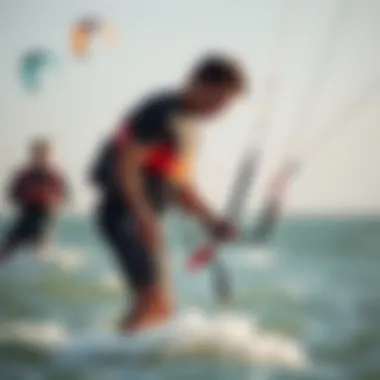
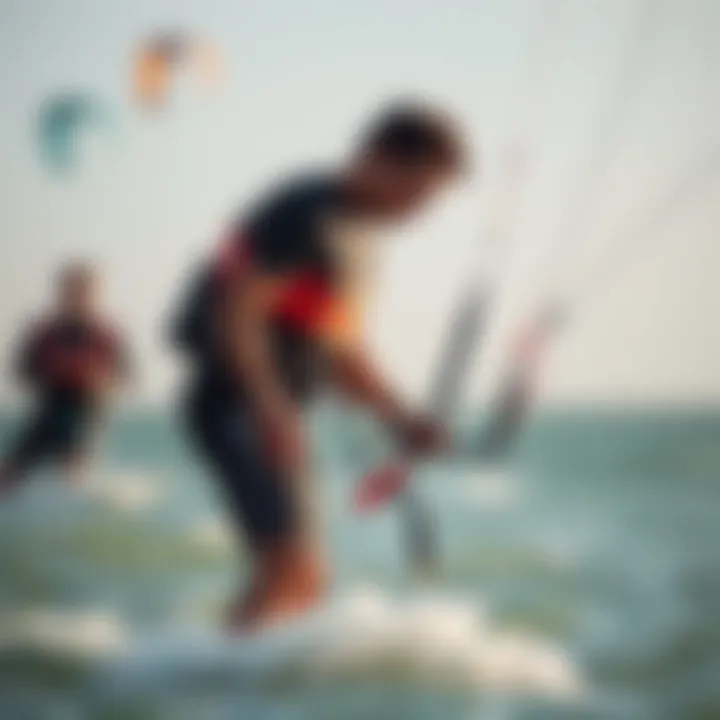
Transitioning to Independent Riding
Once you have a solid grasp of the basics, the next significant step is learning to ride independently. This phase is vital because it encapsulates everything you've learned up to this point—balance, control, and timing. It’s like hopping off the training wheels of a bike; you may waver at first, but eventually, you gain stability.
To make this leap, consider the following:
- Practice, Practice, Practice: The more time you spend on the water, the more natural it becomes. Start in manageable conditions—choose days with steady winds that are not too strong.
- Self-Sufficient Setup: Get comfortable with setting up your equipment without assistance. Know how to launch your kite, adjust your lines, and pack up when you’re done. It builds confidence!
- Navigational Skills: Learning to control your direction is crucial. Start practicing turns and figure eights. It's about getting the feel of the kite pulling you in various directions.
The achievement of independent riding enhances your connection with the kite and the board. You learn to feel the dynamics at play, and your enjoyment increases tenfold.
"Progress means leaving your comfort zone. Every wave conquered, every gust allows you to soar higher."
Exploring Advanced Techniques
Once you've acclimated to independent riding, the real fun begins. Advancing your skills not only amplifies the thrill but also keeps the sport exciting. Here are a few advanced techniques to consider:
- Jumping: Once you feel stable, experimenting with jumps can elevate your experience. This entails understanding timing and the right conditions. Timing your pop with the kite's pull is key. Strive for a gentle pull, think about catching the edge, and let the kite do the work.
- Tricks and Spins: As your confidence grows, you can dabble in tricks. Start slowly—adding spins to your jumps, like 180 or even 360 degrees. It’s all about body positioning and kite control.
- Riding in Different Conditions: Each spot offers unique elements. Explore varying conditions, from choppy waters to flat lakes. Pushing your limits in different terrains hones adaptability—an essential skill for any proficient kitesurfer.
By embracing this progression from basic riding to advanced tricks, you're not just becoming a better kiter; you’re also enhancing your overall enjoyment. Celebrate each milestone, be it small or significant, because they are what make you the kitesurfer you aspire to be.
In summary, the road to proficiency in kitesurfing is an exhilarating ride. Each phase demands patience, persistence, and practice but brings rewarding experiences that will resonate with you for years to come. Stay connected to your fellow kitesurfers and keep the passion alive, for the journey is just as thrilling as the destination.
The Environmental Impact of Kitesurfing
Kitesurfing is not just a thrilling adventure sport; it's also an activity that brings with it certain environmental responsibilities. As the popularity of kitesurfing grows, so does the necessity to understand its impact on coastal ecosystems and local wildlife. In this section, we explore the importance of environmental consciousness amongst kitesurfers and how individuals can contribute positively to their surroundings while enjoying the sport they love.
Promoting Environmental Responsibility
The ocean is our playground, and with that comes the duty to protect it. Kitesurfers often frequent pristine beaches and coastal areas, which are habitats for diverse flora and fauna. By being proactive stewards of these environments, we can ensure that these areas remain vibrant for future generations.
Consider the following ways to promote environmental responsibility:
- Choose Pollution-Free Locations: Opting for spots that have clean water and minimal litter is a simple step. Dirty beaches impact both marine life and the enjoyment of kitesurfing.
- Stick to Designated Launch Areas: New enthusiasts might not realize that there are often designated areas for launching kites. Respecting these zones helps protect vegetation and nesting areas for local wildlife.
- Educate Fellow Riders: Share knowledge about the importance of preserving our beaches. Awareness can go a long way in fostering a community that respects nature.
Connecting with the Kitesurfing Community
Building a connection with the kitesurfing community is as vital as mastering the technique itself. Engaging with fellow kiteboarders can offer not just friendship but also a treasure trove of insights, support, and opportunities. Those who embrace this social aspect often find the sport more rewarding and enjoyable. When you immerse yourself in the community, you never know what new skills or experiences you could pick up just by chatting with a fellow kitesurfer.
Local Events and Competitions
Participating in local events and competitions can be a game changer, especially for those new to kitesurfing. These gatherings are often filled with experienced riders who are all too eager to share their knowledge. Think of them as learning hubs where you can observe different styles and techniques, adding to your growing library of skills. Not to mention, they are fun and exhilarating! The energy during these events can be quite contagious. You might find yourself pushed to try that jump you’ve been pondering about!
"The thrill of competing or even just attending can ignite your passion in ways you didn’t think were possible."
Besides improving your skills, these events can also help you make valuable connections. Many kitesurfers are keen on mentorship, and you might snag a seasoned rider willing to give you tips without any fuss. Also, be sure to check local listings for freestyle competitions, fun races, or community gatherings. Websites like Facebook or event pages specific to your location can keep you informed about upcoming happenings.
Online Resources and Forums
In this digital age, connecting with the kitesurfing community goes far beyond local beaches. Online resources and forums are an absolute gold mine for any enthusiast. Whether you’re looking for advice on gear, tips for improving your technique, or even just sharing your progress, online platforms are teeming with people who share the same passion. Websites like Reddit host vibrant communities where you can ask questions and get feedback from experienced riders.
Moreover, many kiteboarding brands have sustained online forums or social media groups. They not only help you to stay informed on the latest equipment, but some also host virtual meet-ups or instructional sessions. Following channels related to kitesurfing on platforms like YouTube won’t just keep you entertained; it’s also a fantastic way to observe professionals. YouTube has countless tutorials where kiteboarders dissect various techniques, making it easier to grasp complex moves you might want to implement into your own routine.
Engaging in these online spaces allows you to stay connected with the global kitesurfing community, stepping into a wider network of people who share the same zest for the waves. The blend of local and online engagement can remarkably enhance your kitesurfing journey.
Connecting with others fosters a shared spirit of enthusiasm and responsibility toward the sport, benefiting not just you, but also the community around you.
Closure
As we reach the conclusion of this guide, it’s essential to area the significance of what we’ve covered. Kitesurfing is not merely a recreational activity, it's a blend of art and science that can bring you closer to nature and challenge your limits. Within this article, we delved into various aspects ranging from understanding the fundamental concepts to more intricate details about progressing in the sport. Each component we explored plays a crucial role in ensuring that both beginners and seasoned enthusiasts can enjoy the thrill of kitesurfing safely and responsibly.
Recap of Key Insights
To holistically encapsulate the essence of your kitesurfing journey, here are some vital takeaways:
- Selecting the Right Location: Finding optimal spots based on wind patterns and local conditions is key for a successful learning experience. This choice can significantly influence your performance and enjoyment.
- Understanding Equipment: Familiarity with your gear such as kites, boards, and safety equipment is fundamental. This knowledge aids in better performance and enhances your overall safety.
- Importance of Instruction: Choosing a skilled instructor who aligns with your learning style is indispensable. Proper guidance can fast-track your learning process and instill confidence.
- Safety Practices: Always prioritize safety, be it knowledge of local regulations or emergency protocols. Developing a safety-first mindset can protect both you and fellow kitesurfers.
- Environmental Awareness: Committing to eco-friendly practices ensures that our beautiful kitesurfing locations remain pristine for future enthusiasts.
Maintaining these key insights in mind will not only enhance individual experiences but also contribute to a more knowledgeable and responsible kitesurfing community.
Encouragement for Ongoing Learning
Kitesurfing is a lifelong adventure, and as such, there is always room for growth and improvement. Rather than seeing the learning process as finished, view it as an ongoing journey that extends beyond the first few sessions on the water. Engaging with kitesurfing communities, attending workshops, or participating in online forums can keep your knowledge fresh.
Additionally, consider exploring more advanced techniques and styles. Each advance adds another layer to your skills and deepen your understanding of the sport.
Moreover, staying updated with the latest developments in kitesurfing gear and technology is crucial. This will not only improve your performance but also keep you motivated and excited about your practice.
As you carve through the waves and embrace the wind, remember that knowledge is power. The more you learn, the more you can enjoy and share this exhilarating sport with others. Don’t hesitate to dive deeper into resources—consider following related discussions on platforms like Reddit or leveraging educational material from sites like Britannica and Wikipedia.
Ultimately, keep the spirit of exploration alive; let your passion for kitesurfing drive you forward. Stay curious, stay safe, and continue sharing your experiences. This empowers not just yourself but contributes to the stunning world of kitesurfing for everyone.















